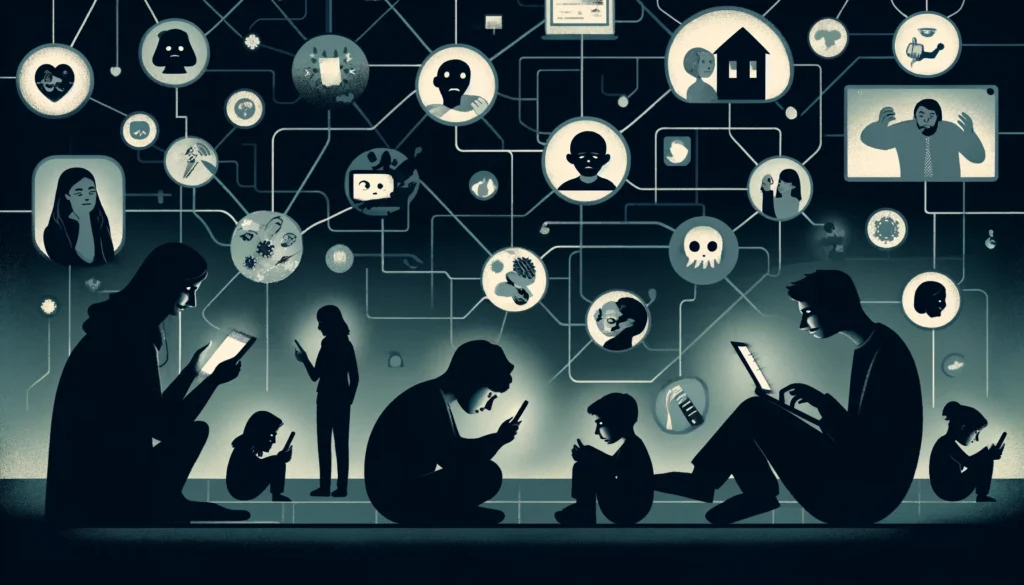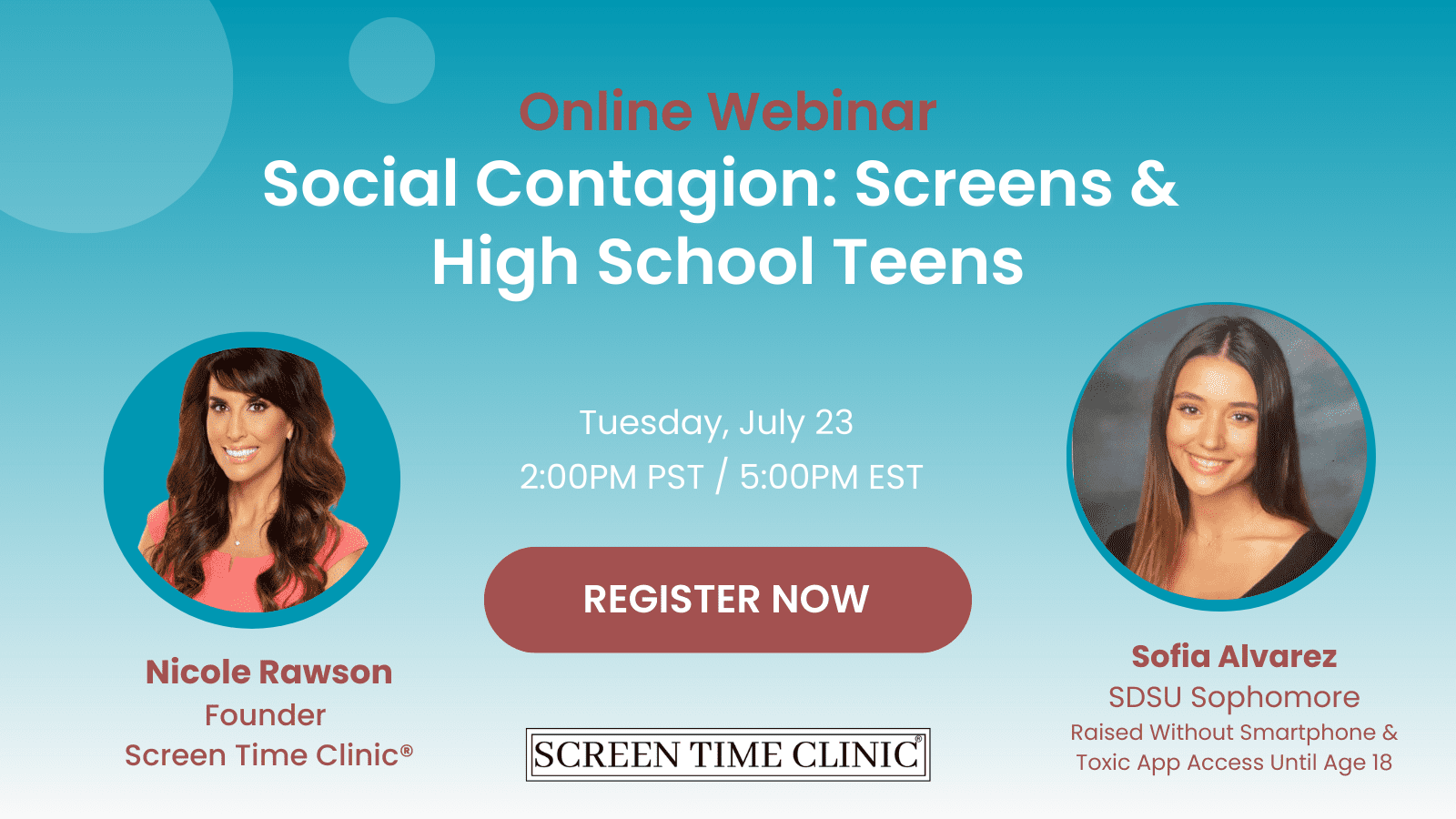

Social contagion is a well studied phenomenon where ideas, behaviors, and emotions spread through populations, much like infectious diseases. While the term might seem modern, the concept has roots stretching back to ancient times. Today, social contagion has taken on whole new dimensions with the advent of the internet and advances of AI’s ability to morph social media’s content to each user, profoundly impacting youth and sensitive individuals like those on the Autism Spectrum.
This is a topic talked about during all of the corporate and youth focused presentations at Screen Time Clinic® yet one of the most overlooked sources of sickness by other mental health providers and parent coaches. The history of social contagion, its current implications, and the role of online content in exacerbating its effects is essential in helping those with mental health struggles, OCD, ticks, ADHD, and physical aliments that fail to improve with traditional interventions until exposure to digital media is removed to allow the brain and body to recover from repeated exposure to content and people online or via text message. What to learn more? Register to the upcoming webinar on this topic, “Social Contagion: Screens & High School Teens”.
Historical Overview
Ancient Times
The concept of social contagion can be traced back to ancient societies where mass behaviors were observed and documented. For instance, the idea of “mob psychology” was noted by the Greeks and Romans, who recognized how emotions and actions could spread rapidly through crowds. Thucydides, the ancient Greek historian, documented the Peloponnesian War and described how panic and fear spread through Athens during the plague, showing early awareness of social contagion.
The Middle Ages
During the Middle Ages, social contagion was often linked to religious fervor and superstition. Events like the dancing plagues of Europe, where groups of people would dance uncontrollably for days, sometimes until death, were early examples of mass psychogenic illness. These incidents were poorly understood but clearly demonstrated how behaviors and emotions could spread rapidly through populations.
The 19th and 20th Centuries
The Industrial Revolution and urbanization brought new challenges and insights into social contagion. The rise of newspapers and other mass media in the 19th century allowed ideas to spread more rapidly than ever before. Gustave Le Bon’s work, “The Crowd: A Study of the Popular Mind” (1895), highlighted how individuals in crowds could be influenced to adopt a collective mindset, often leading to irrational behaviors.
In the 20th century, psychologists like Sigmund Freud and Carl Jung explored how societal norms and collective unconscious could influence individual behavior. The mid-20th century saw the rise of mass media, which significantly enhanced the reach of social contagion through television and radio.
Social Contagion in the Digital Age
The Internet and Social Media
The advent of the internet and social media has exponentially increased the speed and reach of social contagion. Platforms like Facebook, Twitter, and Instagram allow for the rapid dissemination of information, ideas, and emotions without any segmentation of ages and vulnerabilities. This connectivity has brought many benefits, such as increased awareness and social movements, but it has also exacerbated the spread of harmful content.
Impact on Youth and Sensitive Individuals
Youth and sensitive individuals on the Autism Spectrum are particularly vulnerable to the effects of social contagion online due to lack of distrust and fast bonding with content that relates to them and their deep desire to belong to a group and act like them. The constant exposure to curated content, often highlighting violence, depression, and other negative themes, can lead to the internalization of these issues. Studies have shown that excessive use of social media is linked to increased rates of anxiety, depression, and other mental health issues among teens and young adults.
One significant aspect of social contagion in the digital age is the spread of mental health issues. A study published in the Journal of Adolescent Health found that exposure to self-harm and suicide-related content online can increase the likelihood of these behaviors among viewers . Another study in Clinical Psychological Science highlighted how depressive symptoms could spread through social networks, particularly among adolescents .
The Role of AI and Algorithm-Driven Content
Artificial intelligence and algorithm-driven content play a crucial role in amplifying social contagion. Algorithms designed to maximize user engagement often prioritize content that evokes strong emotional responses, whether positive or negative. This can lead to the proliferation of highly relatable, yet potentially harmful, content. Since violent, depressing, sexual and shocking content engages and captivates MORE, users are shown more and more of this content even if they never express initial interest in extreme content subject matter.
Research published in Nature Human Behaviour indicates that algorithms can create echo chambers and filter bubbles, reinforcing users’ existing beliefs and emotions . This can result in a feedback loop where negative content is continually reinforced and amplified, increasing the spread of mental health issues and other harmful behaviors.
Addressing the Challenges: It Takes A Village
To mitigate the negative effects of social contagion, especially among youth and sensitive individuals, several steps can be taken:
- Parental Guidance: Parents should be encouraged to engage in open discussions with their children about their online experiences and explain why they are choosing the delay social media access until adulthood to prevent the chance of unintended harms which far outweigh the entertainment benefits.
- Digital Wellness Interventions: Taking an extended digital detox can alleviate many symptoms absorbed and reinforced online.
- Algorithm Transparency & Accountability for Content: Social media companies should be more transparent about how their algorithms work and take responsibility for the content they promote that results in harm to their viewers.
- Mental Health Support: Increased access to mental health resources by professionals knowledgable about the impact of digital media, can provide support for those affected by harmful online content. If digital media is not address during therapeutic interventions, patients often fail to show signs of improvement even with medication.
Conclusion
Social contagion is an age-old phenomenon that has evolved significantly into a mass source of problems with the advent of the internet and social media. While it has the power to spread positive ideas and movements, it also poses significant risks, particularly for youth and sensitive individuals. Understanding the history and current implications of social contagion is crucial in developing strategies to mitigate its harmful effects in our increasingly connected world.
References
- Journal of Adolescent Health: Study on the impact of self-harm and suicide-related content on viewers.
- Clinical Psychological Science: Study on the spread of depressive symptoms through social networks.
- Nature Human Behaviour: Research on the role of algorithms in creating echo chambers and filter bubbles.

